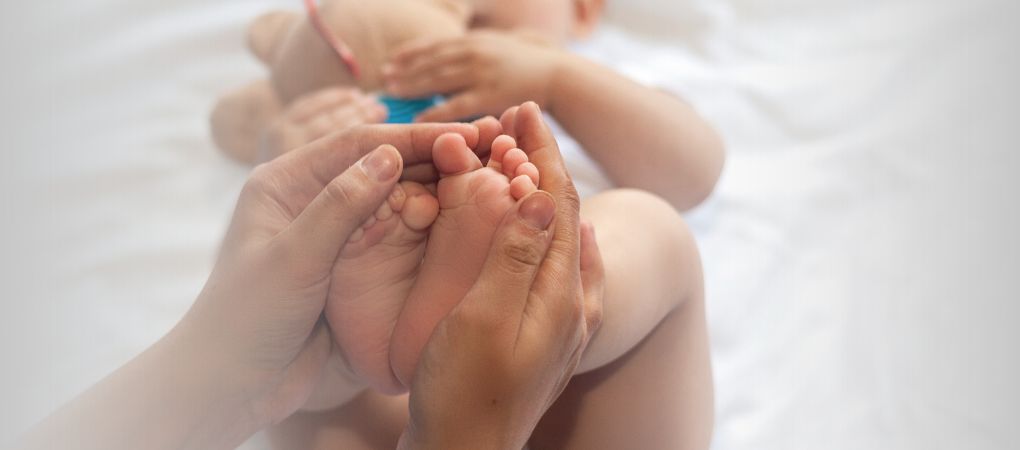Francesca Galiano
|
29/12/2023 - Last update 03/01/2024
Elda Andreoli, Andrea Troiani, Valentina Tucci, Gina Barlafante, Francesco Cerritelli, Gianfranco Pizzolorusso, Cinzia Renzetti, Daniele Vanni, Andrea Pantalone, Vincenzo Salini | Year 2014
Osteopathic manipulative treatment of congenital talipes equinovarus: a case report
Pathology:
Club foot
Type of study:
Case Report
Date of publication of the study’:
2014/Jan/01

Purpose of the study
- Objective: to show the possible usefulness of OMT, in combination with two sets of leg casts, in cases of congenital talipes equinovarus (club foot).
- Measured outcomes: degree of severity of club foot through Dimeglio scoring system.
Participants
- Number: 1
- Description: a 12-day-old girl with club foot in both lower limbs. She was born full-term at 39 weeks’ gestation via vaginal delivery, and no complications during pregnancy, No disease of any kind was noted at birth. The mother, a 35-year-old woman at her third pregnancy, took vasosuprine because of premature uterine contractions at 20 weeks gestation. A part from that, she did not a smoke or drink alcohol. Neither she nor her husband (33) had any genetic or congenital disorders or history of diseases in their life.The first orthopedic examination was when the girl was 12 days old. The orthopedist assessed the ROM of the feet and, reported a score of 13 points for the right foot and 14 points for the left foot on the Dimeglio scoring system, showing a severe degree of deformity. No radiographs were taken to evaluate any anatomical abnormalities.After that, the surgeon applied a cast to both legs from the knee down, without the use of anesthesia and using minimal force, in order to promote the body’s self-regulation processes. The casts were kept on for 8 days, and by day 20 the feet were already showing improvement (however, a goniometric examination was not performed). Therefore, a second set of casts was applied, again with minimal force. A third visit was then scheduled at 33 days of age.
In the meantime, the child was evaluated and treated by an osteopath.
Interventions and evaluations
- Assessment and treatment at ages 5, 10, 17 and 24 days.
- Sequence, dose and frequency of treatment left to the discretion of the osteopath.
- OMT:
- Evaluation of somatic dysfunction at cervical, skull base, rib, diaphragm, thoracolumbar spine, sacrum, tibia, and hip level (the latter only in the first two sessions, given the presence of casts in the following sessions).
- Use of indirect myofascial release techniques against the evaluation of multiple factors: age of the child, safety, physical condition (ie, presence of casts), and experience with the techniques.
Results
At the age of 33 days, that is, during the third orthopedic visit, the child showed complete correction of the clubfoot in both legs and recovery of mobility. Therefore, no further casts or orthoses were placed.
The child was then checked for 18 months as a follow-up and showed no recurrence of any deformity.
Discussion
In conjunction with the application of two sets of casts, OMT appears to have promoted correction of the club foot in this case. In fact, the use of techniques directed at promoting the release of fascial restrictions may have had consequent anti-inflammatory and neuroendocrine effects.
As the fascia is the tissue that surrounds organs, muscles, bones, and blood vessels, it can profoundly affect their development and formation, and therefore their mechanics and physiology. The myofascial release techniques have then been directed at the fascia, but also at muscles, ligaments, tendons, and cartilage. By applying the techniques to these collagenous structures, from an orthopedic point of view, is crucial in order to favor the repositioning of the foot structures.
Club foot is a special condition, not only because of the impact it can have on sensorimotor development, but precisely because of its nature: to date, its etiology is not clearly known, nor are the existing systems of diagnosis universally agreed upon. Moreover, with regard to treatment, given also the anatomical complexity of feet and hips, there is no standardized protocol. There are instead different approaches, including intensive physiotherapy, casts, orthoses, and even surgery. Always taking into account a possible relapse in the long term.
In this study, the absence of adverse events and the fact that the parents did not need to take osteopathic therapy home, were very interesting factors. In addition, the osteopathic sessions lasted less than the average duration of a classic physiotherapy program (6 weeks).
The review of Osteopedia
By Marco Chiera
Strengths: probably, the first study on OMT (but also other complementary approaches) and club foot; good description of the state of the art on club foot; follow-up evaluation.
Limits: like all case reports, it is difficult to generalize it.

Are you an osteopath?
Register and enjoy the membership benefits. Create your public profile and publish your studies. It's free!
Register now
School or training institution?
Register and enjoy the membership benefits. Create your public profile and publish your studies. It's free!
Register now
Do you want to become an osteopath? Are you a student?
Register and enjoy the membership benefits. Create your public profile and publish your studies. It's free!
Register now







